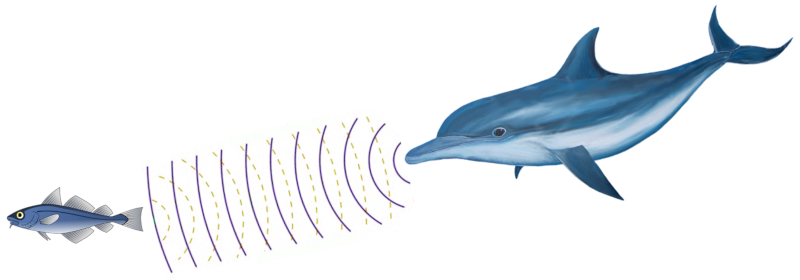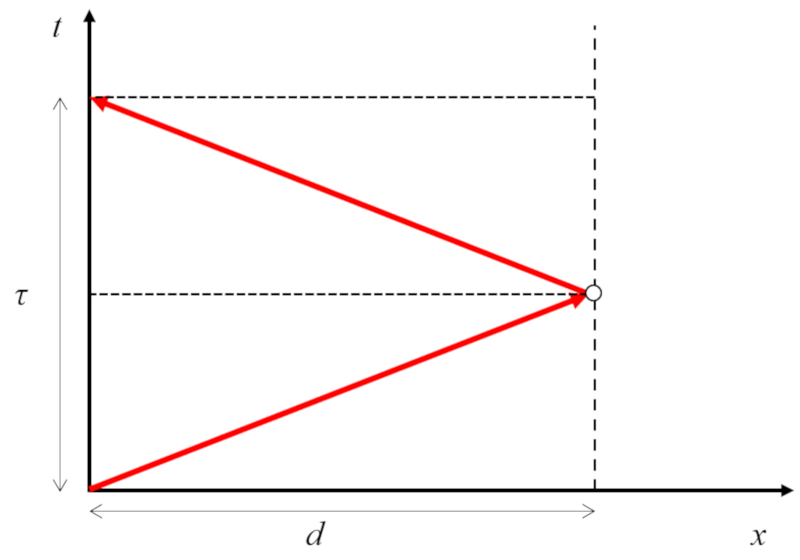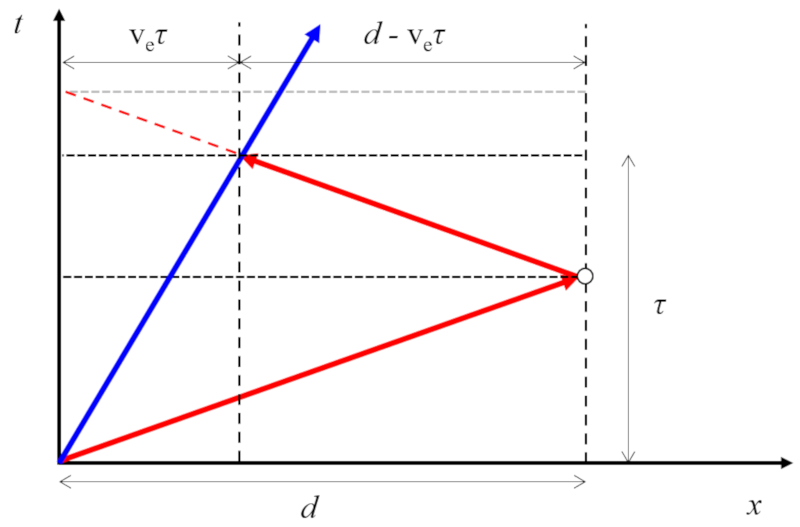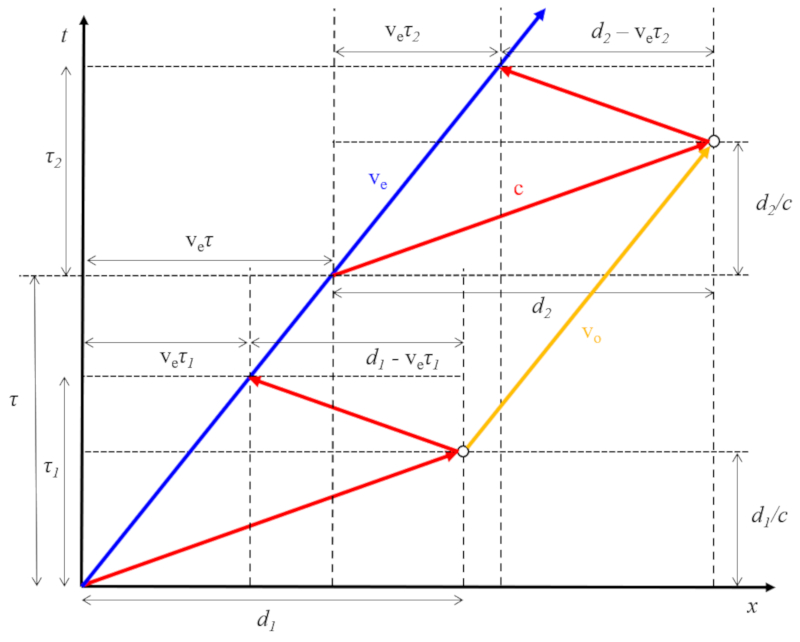Sonar
Storyboard 
Another use of sound in water is sonar, employed both as a technological tool and as a technique used by whales and dolphins (biosonar) to determine distances.
Biosonar is used for navigation and hunting, estimating distances and even velocities to predict the future movement of prey.
ID:(1597, 0)
Sonar principle
Image 
The principle of sonar is the emission of sound that is then reflected in the object to be studied and is finally captured by the emitter. The distance of the sound wave is determined from the travel time of the sound wave and the speed in the medium.

There are three situations of interest:
• Emitter and reflector are at rest
• Emitter in motion and reflector at rest
• Emitter and reflector at rest
ID:(11869, 0)
Emitter and reflector are at rest
Concept 
In the case where both the transmitter and the reflector remain stationary, the path traveled by the sound is equal to twice the emitter and reflector distance are at rest (d):

Since the distance is covered at the speed of sound (c) in the echo time (\tau_1), we have that the emitter and reflector distance are at rest (d) is:
| d = \displaystyle\frac{1}{2} c \tau_1 |
ID:(11870, 0)
Emitter in motion and reflector at rest
Concept 
In the case where the transmitter moves at a velocity the emitter speed (v_e) and the reflector is at rest, the reflector starting distance (d_0) varies depending on whether the sound traveling at the speed of sound (c) requires the echo time (\tau_1) to be greater (if the bodies move apart) or smaller (if the bodies move closer):

Therefore, the reflector starting distance (d_0) is equal to
| d_0 = \displaystyle\frac{1}{2} (c + v_e) \tau_1 |
and the position of the reflector relative to the transmitter is
| x = \displaystyle\frac{1}{2}( c + v_e ) \tau_1 - v_e t |
as a function of the time from start of trace (t).
ID:(11871, 0)
Emitter and reflector in motion
Concept 
In the case where the emitter moves at a speed of the emitter speed (v_e) and the reflector moves at a speed of the reflector or receiver speed (v_o), the distance between the emitter and the reflector can be either greater (v_e > v_o) or smaller (v_e < v_o). If we represent this situation including the echo time (\tau_1), the second echo time (\tau_2), and the time between pulses (\tau), we obtain:

By calculating the distance traveled and the time elapsed by the reflector between both pulses, we obtain the reflector or receiver speed (v_o) as follows:
| v_o = \displaystyle\frac{2 v_e \tau + ( c + v_e )( \tau_2 - \tau_1 )}{2 c \tau + ( c + v_e )( \tau_2 - \tau_1 )}c |
Knowing both the emitter speed (v_e) and the reflector or receiver speed (v_o), we can express the relative position emitter in motion and reflector at rest (x) in terms of the time from start of trace (t) as follows:
| x =\displaystyle\frac{(2 \tau \tau_1 +( \tau_2 - \tau_1 ) t )( c - v_e )( v_e + c )}{( v_e + c )( \tau_2 - \tau_1 )+2 c \tau )} |
with the speed of sound (c).
ID:(11872, 0)
Model
Top 
Parameters
Variables
Calculations
Calculations
Calculations
Equations
d = \displaystyle\frac{1}{2} c \tau_1
d = c * tau_1 /2
d_0 = \displaystyle\frac{1}{2} (c + v_e) \tau_1
d_0 =( c + v_e )* tau_1 /2
v_o = \displaystyle\frac{2 v_e \tau + ( c + v_e )( \tau_2 - \tau_1 )}{2 c \tau + ( c + v_e )( \tau_2 - \tau_1 )}c
v_o = c *( 2* v_e * tau + ( c + v_e )*( tau_2 - tau_1 ))/(2* c * tau + ( c + v_e )*( tau_2 - tau_1 ))
x = \displaystyle\frac{1}{2}( c + v_e ) \tau_1 - v_e t
x = ( c + v_e )* tau_1 /2 - v_e * t
x =\displaystyle\frac{(2 \tau \tau_1 +( \tau_2 - \tau_1 ) t )( c - v_e )( v_e + c )}{( v_e + c )( \tau_2 - \tau_1 )+2 c \tau )}
x =((2* tau * tau_1 +( tau_2 - tau_1 )* t )*( c - v_e )*( v_e + c ))/(( v_e + c )*( tau_2 - tau_1 ) + 2* c * tau ))
ID:(15469, 0)
Emitter and reflector distance are at rest
Equation 
If there is no movement, the time required for signal the echo time (\tau_1) to travel at the speed of sound the speed of sound (c) is c \tau, which is twice the distance between the transmitter and the reflector.
Therefore, the emitter and reflector distance are at rest (d) is:
ID:(11873, 0)
Moving emitter distance and reflector at rest
Equation 
In the case where the emitter moves at a speed of the emitter speed (v_e) and the reflector remains stationary, its initial distance the reflector starting distance (d_0) can be estimated using the echo time the echo time (\tau_1). In this scenario, the distance traveled equals c \tau_1, which is equal to the initial distance between the emitter and reflector the reflector starting distance (d_0), plus the return trip, which is the same d_0 minus the distance traveled by the emitter v_e\tau_1. Hence, we have:
d_0 + d_0 - v_e\tau_1 = c\tau_1
or that the reflector starting distance (d_0) is:
ID:(11874, 0)
Relative position emitter in motion and reflector at rest
Equation 
To determine the relative position emitter in motion and reflector at rest (x), one must consider the reflector starting distance (d_0) and subtract the path traveled by the emitter. This latter is calculated from the emitter speed (v_e) and the time from start of trace (t), resulting in:
ID:(11876, 0)
Moving reflector speed
Equation 
The reflector or receiver speed (v_o) can be calculated from the emitter speed (v_e) and the speed of sound (c), along with the echo time (\tau_1), the second echo time (\tau_2), and the time between pulses (\tau), using the formula:
With the distance to the object when emitting first signal (d_1) and the speed of sound (c), one can estimate the time at which the first signal reflects as d_1/c, and with the distance to the object when emitting second signal (d_2), the second time as \tau + d_2/c. Therefore, the time between the reflections of the two signals is given by:
\Delta\tau = \tau + \displaystyle\frac{ d_2 }{ c } - \displaystyle\frac{ d_1 }{ c }
The position where the first signal reflects is the distance to the object when emitting first signal (d_1), and the second is ($$). Hence, the distance traveled by the reflector is:
\Delta x = v_e \tau + d_2 - d_1
Thus, the velocity of the reflector is:
v_o=\displaystyle\frac{\Delta x}{\Delta t}=\displaystyle\frac{ v_e\tau + d_2 - d_1}{ \tau + \displaystyle\frac{d_2}{c} - \displaystyle\frac{d_1}{c}}
As mentioned earlier in echo time s, emitter speed m/s, reflector starting distance m and speed of sound m/s, the difference between the distances traveled is given by:
d_2-d_1=\displaystyle\frac{1}{2}( c + v_e )( \tau_2 - \tau_1 )
and the resulting velocity is:
| v_o = \displaystyle\frac{2 v_e \tau + ( c + v_e )( \tau_2 - \tau_1 )}{2 c \tau + ( c + v_e )( \tau_2 - \tau_1 )}c |
ID:(11877, 0)
Moving emitter and reflector distance
Equation 
Para calcular la posición relativa entre emisor y reflector se debe describir primero la posición del reflector y luego restar la del emisor. Este ultimo se mueve a una velocidad
d_1 + v_o\left(t - \displaystyle\frac{d_1}{c}\right) = v_ot + d_1\left(1 -\displaystyle\frac{v_o}{c}\right)=v_ot + \left(1 -\displaystyle\frac{v_o}{c}\right)\left(1 +\displaystyle\frac{v_e}{c}\right)c\tau_1
Como el emisor reduce la distancia en el tiempo según
v_et
se tiene que la distancia efectiva entre objeto y emisor es con
ID:(11875, 0)
